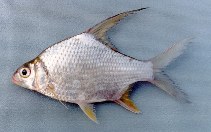http://www.fishbase.org/Summary/speciesSummary.php?genusname=Puntioplites&speciesname=falcifer ---> http://52.67.158.155/Summary/speciesSummary.php?genusname=Puntioplites&speciesname=falcifer
http://52.67.158.155/Summary/speciesSummary.php?genusname=Puntioplites&speciesname=falcifer ---> https://fishbase.net.br/Summary/speciesSummary.php?genusname=Puntioplites&speciesname=falcifer
https://fishbase.net.br/Summary/speciesSummary.php?genusname=Puntioplites&speciesname=falcifer ---> https://fishbase.net.br/summary/Puntioplites-falcifer.html
Puntioplites falcifer : fisheries

You can
sponsor
this page
Common name (e.g. trout)
Genus + Species (e.g. Gadus morhua)
-

-
About this page
-
Languages
-
User feedbacks
-
Citation
-
Uploads
-
Related species
-


 Upload your
photos
and
videos
Upload your
photos
and
videos
Pictures
|
Google image
 Puntioplites falcifer
Puntioplites falcifer
Picture by
Warren, T.
Teleostei (teleosts) >
Cypriniformes
(Carps) >
Cyprinidae
(Minnows or carps) > Cyprininae
Etymology:
Puntioplites:
Latin, punctum = point, the point of the sword + Greek, hoplon = weapon (Ref.
45335
)
.
More on author:
Smith
.
Environment: milieu / climate zone / depth range / distribution range
Ecology
Freshwater; benthopelagic; potamodromous (Ref.
51243
). Tropical
Asia: Mekong basin.
Size / Weight / Age
Maturity: L
m
?
range ? - ? cm
Max length : 40.0 cm male/unsexed; (Ref.
37770
)
Last simple anal ray osseus and serrated posteriorly; pale orange anal, pelvic and dorsal fins; last simple dorsal ray reaching the caudal fin in adults and with 28-36 serrae (in specimens 6-15 cm SL) (Ref.
27732
); serrated anal spine; silvery body coloration (Ref.
12693
).
Inhabits large upland rivers. Seems to avoid standing water. Little is known about its biology. Like other members of the genus, it probably feeds mainly on plant matter and occasionally on insects and insect larvae (Ref.
12693
). Also reported to prefer deep pools in the river and to migrate into streams, canals and lakes during the flood season. Migrates in large schools (Ref.
37770
). Migrates together with
Cosmochilus harmandi
,
Cirrhinus
spp.,
Labeo chrysophekadion
and
Bangana
sp (Ref.
37770
). Marketed fresh (Ref.
12693
).
Life cycle and mating behavior
Maturity
|
Reproduction
|
Spawning
|
Eggs
|
Fecundity
|
Larvae
Rainboth, W.J.
, 1996. Fishes of the Cambodian Mekong. FAO species identification field guide for fishery purposes. FAO, Rome, 265 p. (Ref.
12693
)
IUCN Red List Status (Ref.
130435
)
Least Concern (LC)
; Date assessed:
20 February 2011
CITES
Not Evaluated
Not Evaluated
Threat to humans
Harmless
Human uses
Fisheries: commercial
FAO - Publication:
search
|
FishSource
|
More information
Countries
FAO areas
Ecosystems
Occurrences
Introductions
Stocks
Ecology
Diet
Food items
Food consumption
Ration
Common names
Synonyms
Metabolism
Predators
Ecotoxicology
Reproduction
Maturity
Spawning
Spawning aggregation
Fecundity
Eggs
Egg development
Age/Size
Growth
Length-weight
Length-length
Length-frequencies
Morphometrics
Morphology
Larvae
Larval dynamics
Recruitment
Abundance
BRUVS
References
Aquaculture
Aquaculture profile
Strains
Genetics
Electrophoreses
Heritability
Diseases
Processing
Nutrients
Mass conversion
Collaborators
Pictures
Stamps, Coins Misc.
Sounds
Ciguatera
Speed
Swim. type
Gill area
Otoliths
Brains
Vision
Tools
E-book
|
Field guide
|
Length-frequency wizard
|
Life-history tool
|
Point map
|
Classification Tree
|
Catch-MSY
|
Special reports
Check for Aquarium maintenance
|
Check for Species Fact Sheets
|
Check for Aquaculture Fact Sheets
Download XML
Summary page
|
Point data
|
Common names
|
Photos
Internet sources
AFORO (otoliths) |
Aquatic Commons
|
BHL
|
Cloffa
|
BOLDSystems
|
Websites from users
|
Check FishWatcher
|
CISTI
|
Catalog of Fishes
:
genus
,
species
|
DiscoverLife
|
ECOTOX
| FAO - Publication:
search
|
Faunafri
| Fishipedia |
Fishtrace
| GenBank:
genome
,
nucleotide
|
GloBI
|
Google Books
|
Google Scholar
|
Google
| IGFA World Record |
MitoFish
|
Otolith Atlas of Taiwan Fishes
|
PubMed
| Reef Life Survey | Socotra Atlas |
Tree of Life
| Wikipedia:
Go
,
Search
| World Records Freshwater Fishing |
Zoobank
|
Zoological Record
Estimates based on models
Phylogenetic diversity index (Ref.
82804
): PD
50
= 0.5625 [Uniqueness, from 0.5 = low to 2.0 = high].
Bayesian length-weight: a=0.00933 (0.00528 - 0.01648), b=2.95 (2.80 - 3.10), in cm total length, based on LWR estimates for this species & (Sub)family-body (Ref.
93245
).
Trophic level (Ref.
69278
): 2.6 ±0.26 se; based on food items.
Resilience (Ref.
120179
): Medium, minimum population doubling time 1.4 - 4.4 years (Preliminary K or Fecundity.).
Fishing Vulnerability (Ref.
59153
): Moderate vulnerability (36 of 100).
Price category (Ref.
80766
):
Unknown
.
Back to Search
Random Species
Back to Top
Accessed through:
Not available
FishBase mirror site :
Laguna, Philippines
Page last modified by :
mrius-barile
|